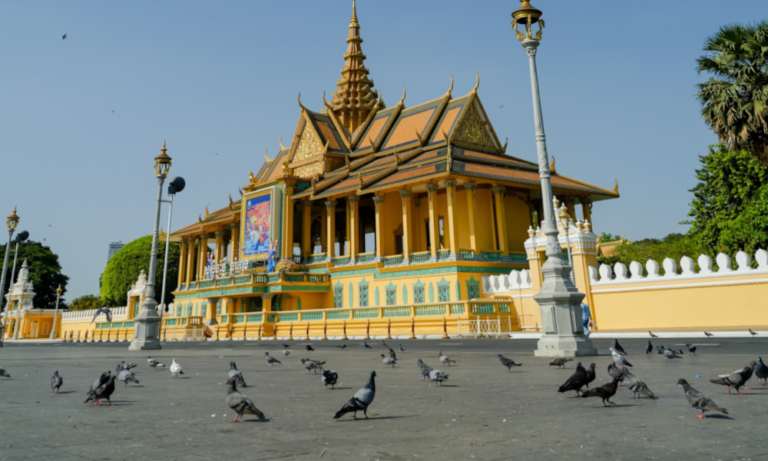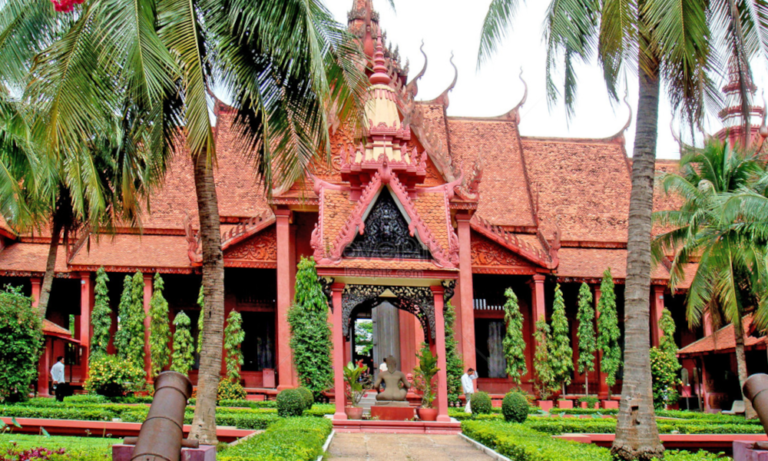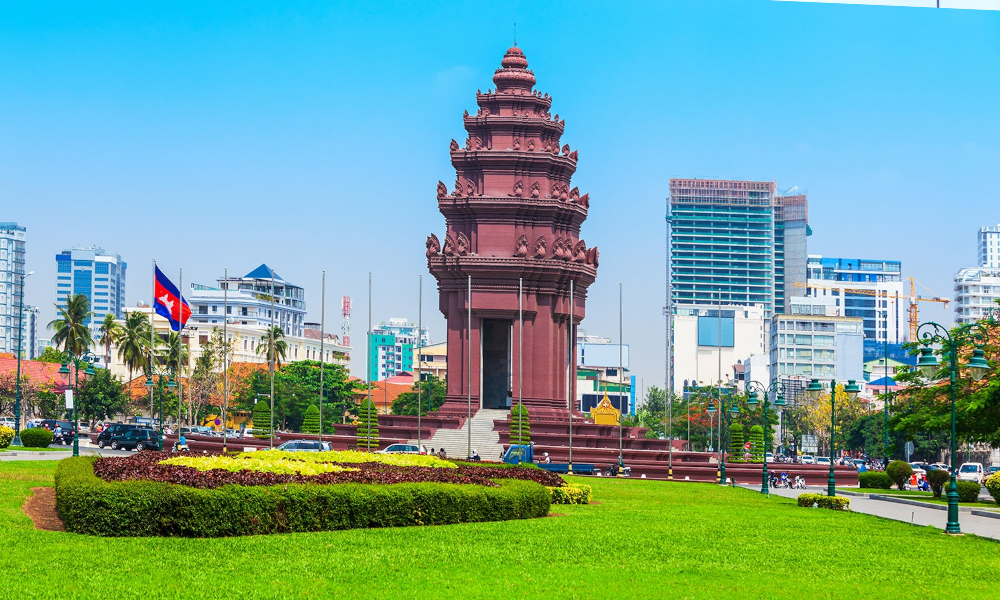Phnom Penh: The Capital City Of Cambodia

Cambodia‘s capital city, Phnom Penh, often called the ‘pearl of Asia’, holds considerable importance for various political, economic, and cultural reasons. Despite the lively atmosphere typical of larger Asian cities, characterized by numerous mopeds, Phnom Penh maintains its allure through a wealth of historical landmarks, museums, and memorials. This is complemented by an intriguing café culture, exceptional culinary offerings, and vibrant nightlife, which collectively attract both tourists and residents.
General Information of Phnom Penh
Phnom Penh is the lively and dynamic capital of Cambodia. Nestled at the meeting point of three rivers—the powerful Mekong, the Bassac, and the expansive Tonle Sap—this city was once hailed as the ‘Gem’ of Indochina. Today, it still retains a significant charm, offering a wealth of sights to explore. With its blend of provincial allure and serenity, visitors can admire French colonial mansions and tree-lined streets alongside impressive Angkorian architecture. Compared to the fast-paced modernity of other Asian capitals, Phnom Penh feels like a refreshing oasis. The city is a delightful mix of Asian culture, and the renowned Cambodian hospitality warmly welcomes all who visit.
In the heart of the capital, there are numerous fascinating attractions. In addition to the Royal Palace, the Silver Pagoda, the National Museum, the Toul Sleng Genocide Museum, the Choeng Ek Killing Fields, and Wat Phnom, visitors can explore various markets filled with carvings, paintings, silk, silver, gems, and antiques. It truly is a perfect spot for a leisurely day of exploration. The entire area, including the outskirts, spans about 376 square kilometers and is home to approximately 2,009,264 residents.
The city’s name is derived from the famous Wat Phnom Daun Penh (now simply known as Wat Phnom or Hill Temple), which was constructed in 1373 to enshrine five Buddha statues on a 27-meter-high artificial hill. These statues were discovered floating down the Mekong in a Koki tree, and an elderly wealthy widow named Daun Penh (Grandma Penh) rescued them, placing them on the hill for worship. Phnom Penh was also formerly called Krong Chaktomuk (Chaturmukha), meaning “City of Four Faces,” a name that reflects the confluence of the Mekong, Bassac, and Tonle Sap rivers, which intersect to form an “X” shape at the city’s location.
Phnom Penh serves as the entry point to a fascinating region, featuring the world-renowned Angkor temples, the largest religious complex globally, located to the west. Visitors can also explore the stunning beaches along the southern coast and the diverse ethnic communities in the northeastern provinces. The city offers a broad range of accommodations, from luxurious five-star hotels to affordable guesthouses, along with a delightful mix of dining options, including upscale international restaurants, casual noodle stalls, local pubs, and vibrant international nightclubs.
Geography Of Phnom Penh
Phnom Penh is nestled in the southern part of Cambodia and is completely encircled by Kandal Province. The city is characterized by the typical wetland areas found in Cambodia, featuring expansive rice fields and various agricultural farms. Additionally, it is home to three of the country’s largest rivers: the Tonle Bassac, the Tonle Sap, and the powerful Mekong.
These rivers converge to create an “X” shape at their meeting point, where the capital is located. They offer valuable freshwater and other essential resources. Covering an area of 375 square kilometers (145 square miles), the city includes approximately 11,401 hectares (28,172 acres) within the municipality and 26,106 hectares (64,509 acres) of roadways. The agricultural land within the municipality spans 34.685 square kilometers (13 square miles), with around 1.476 square kilometers (365 acres) being irrigated.
Population and Climate
The municipality currently has a population of approximately 2,009,264 residents, which represents 14% of Cambodia’s total population of 14,363,519 (as per provincial government data from 2007). This includes 621,948 males and 658,833 females, resulting in a population density of 5,343.8 individuals per square kilometer. The demographic breakdown shows that 60% are Original Khmer, 15% are Chinese, 20% are Vietnamese, and the remaining 5% belong to other ethnic groups. The city’s population is growing at a rate of about 3.9%.
Cambodia experiences a tropical climate characterized by warmth and humidity. The monsoon season brings significant rainfall, which supports the growth of a diverse range of crops. This favorable climate throughout the year makes Cambodia an attractive destination for tourism. Visitors can rest assured that the country is not prone to natural disasters like volcanic eruptions or earthquakes, and it is largely unaffected by tropical storms.
Travelers can enjoy Cambodia at any time of the year. However, those planning to explore by road should be cautious during the last two months of the rainy season, as some rural roads may become difficult to navigate. The average temperature hovers around 27 degrees Celsius, with a minimum of about 16 degrees. December and January are the coolest months, while April tends to be the hottest.
Economy
Economic growth rates in the double digits over recent years have sparked a significant boom, leading to the emergence of new hotels, restaurants, bars, and residential buildings throughout the city. With its rich historical and cultural attractions, Phnom Penh has become a highly sought-after tourist destination. The economy primarily thrives on commerce, including garment production, trading, and small to medium-sized enterprises. The real estate market has seen remarkable growth in recent years, resulting in rising property prices. Two new sub-cities are currently under development, with investors from Korea and Indonesia collaborating with local Cambodian investors. The Camko-city investment project is projected to exceed 200 million dollars and is expected to be completed by 2018.
Thanks to budget airlines offering direct flights from neighboring countries, both leisure and business travelers are flocking to Phnom Penh to enjoy their stay or explore investment opportunities in Cambodia. Consequently, the hotel industry is also experiencing significant improvements.
Kandal province, surrounding Phnom Penh, acts as an economic hub for the capital. For example, in 2007, Cambodia became the sixth largest garment exporter globally, with most factories located in Kandal Province. This industry has created job opportunities for approximately 500,000 Cambodians and generated around 300 million U.S. dollars in monthly wages for employees. Additionally, agricultural exports thrived in 2007, as products like palm oil, peanuts, rice, and pepper gained popularity in international markets.
Lastly, a luxury real estate project, the Longing Resort in Kandal province, was demolished on July 31 due to illegal land expansion, which posed a safety risk to the capital. The Asian Development Bank reported Cambodia’s economic growth rate at 9.5 percent for the past year and 9 percent in 2008, while the Cambodian government provided a more conservative estimate of 7 percent for both 2007 and 2008.
Transportation in Phnom Penh
Phnom Penh is accessible through domestic and international flights, as well as by overland routes and speedboats from nearby provinces and countries. Getting around the city is relatively straightforward. While traffic has become more congested recently, you can still traverse the city in under 40 minutes. With the current economic growth, the volume of traffic has risen considerably.
Phnom Penh International Airport
Upon arrival, you can easily find taxis and motorcycle taxis available just outside the arrival lobby. Currently, there are no metered taxis as this service is still being developed. A taxi ride to the city center will cost around $7.00 and takes about 20-30 minutes. If you’re looking for a more budget-friendly option, motorcycle taxis are available for $3.00, though they are slower and less comfortable. Typically, a taxi ride from the city to the airport ranges from $7 to $10. It’s wise to allow at least 30-40 minutes for your journey to the airport, especially during rush hour when traffic can be heavy.
Cambodia Angkor Airways operates multiple daily flights to and from Phnom Penh. Other affordable options include Bassaca Air and Bayon Airlines. Tourists can also fly with Vietnam Airlines, which offers daily flights to and from Ho Chi Minh City and Hanoi, as well as Singapore Airlines from Singapore, and Laos Airlines from Vientiane. Additionally, Malaysia Airlines provides flights to and from Kuala Lumpur.
Taxi, Bus or Vans
Numerous bus companies, including Giant Ibis, Mekong Express, PSD Xpress, Sorya Bus, Neak Krohorm, Thero Express (15-seat), Larryta, KSO, Virak Buntham, and Cambodia Post VIP Van, provide transportation services to Phnom Penh. These companies operate modern, air-conditioned buses and vans, with departures scheduled every 15 minutes to one hour from 6 AM to midnight. The fares are quite reasonable, and online bus tickets can be purchased in advance.
Phnom Penh Port
The ferry terminal in Phnom Penh is located on Sisowath Quay, which is the road along the riverfront, at Street 104. It’s situated just north of the main area with parks and restaurants by the river. If you’re coming to Phnom Penh, you’ll find plenty of motor taxis and car taxis ready to take you where you need to go. Motorcycle taxis typically cost between R3000 and R5000, while car taxis charge around $3 to $5 to reach hotels in the downtown area.
Check available flight below:
Things to see & Do in Phnom Penh
Where to Stay in Phnom Penh (Suggestion)
1. Rosewood Phnom Penh [ Book Now ]
No. 66 Monivong Blvd, Khan Doun Penh, Phnom Penh
2. Sokha Phnom Penh Hotel [ Book Now ]
Street Keo Chenda, Phume 1, Sangkat Chroy Changvar, Khan Russeykeo, Phnom Penh
3. Courtyard by Marriott Phnom Penh [ Book Now ]
No 115 Street 214 At Corner Street 63, Khan Doun Penh, Phnom Penh
Check available Hotel below:
Tours of Phnom Penh
Phnom Penh Private Tour: 1 Day Tour
Explore the vibrant city of Phnom Penh with a private tour that allows you to customize your itinerary based on your interests. Experience the rich culture, history, and beauty of Cambodia with a personalized guided tour.








There are no reviews yet.